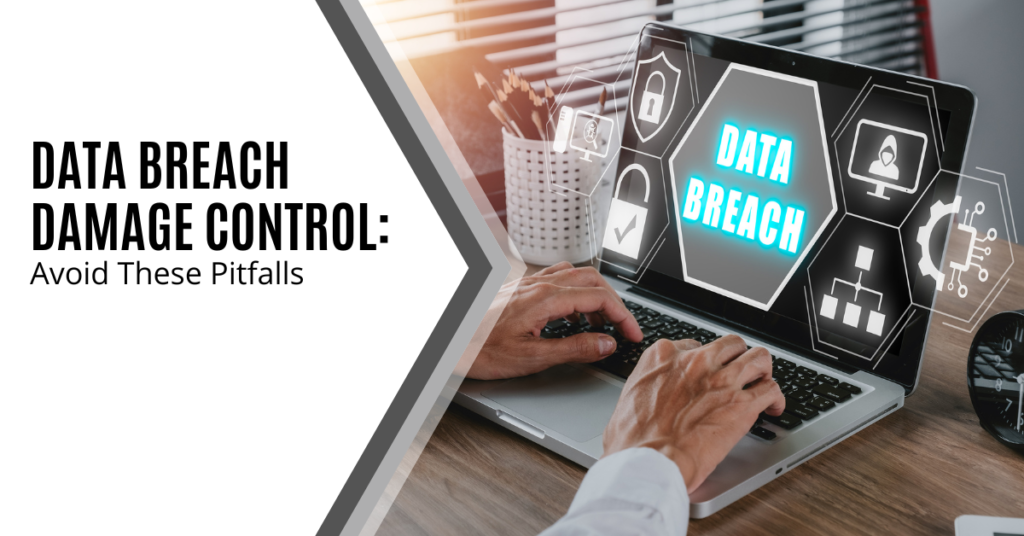|
Getting your Trinity Audio player ready...
|

Data breaches have become an unfortunate reality for organizations of every size. When sensitive information is compromised, the immediate actions a company takes are vital. The way a business manages a breach can greatly influence its reputation, financial stability, and legal standing.
The current average cost of a data breach is estimated at $4.88 million.
Effective management of a data breach requires a strategic approach. However, certain common errors can worsen the impact. This guide outlines essential steps for managing a data breach and highlights common mistakes to avoid.
Pitfall #1: Delayed Response
One of the biggest mistakes following a data breach is delaying the response. Every minute that passes can lead to further data loss and damages. Delaying action can severely undermine customer trust.
Act Fast
The first step in limiting damage is to act quickly. Once a breach is detected, initiate your response plan without delay. This should involve containing the breach, assessing its extent, and notifying anyone affected. Speed is essential to minimize damage.
Notify Stakeholders Immediately
Informing stakeholders, such as customers, employees, and business partners, is essential. Delays in notification can create confusion and panic. Communicate transparently about:
- What occurred
- The type of data compromised
- The actions being taken to address the issue
Prompt communication helps maintain trust and empowers affected parties to protect themselves.
Involve Legal and Regulatory Bodies
In certain cases, notifying regulatory authorities is legally required. Delaying this can lead to legal penalties. Be sure to understand the notification requirements and follow them promptly.
Pitfall #2: Poor Communication
Effective communication is crucial during a data breach. Inadequate or vague messaging can lead to misunderstandings, frustration, and damage to your company’s reputation. How you communicate will shape how others perceive your organization during the crisis.
Set Up Clear Communication Channels
Provide stakeholders with clear communication channels. Consider options such as:
- A dedicated hotline
- Email notifications
- Regular updates on a specific section of your website
Ensure that updates are consistent, transparent, and accurate.
Avoid Technical Jargon
When communicating with non-technical stakeholders, avoid jargon. Use clear, accessible language to explain the situation, the steps you’re taking, and any necessary actions they need to follow.
Provide Ongoing Updates
Continue updating stakeholders as the situation develops. Even if there is no new information, regular updates show that you’re actively managing the breach.
Pitfall #3: Failure to Contain the Breach
Containing the breach promptly is critical. Upon detecting a breach, immediate action helps prevent additional data loss, reducing further damage.
Isolate Affected Systems
The first action in containing a breach is isolating affected systems. This could involve:
- Disconnecting systems from the network
- Disabling user accounts
- Halting specific services
These measures prevent the breach from escalating.
Assess the Damage
After containment, assess the damage to understand the breach’s scope. Identify the data that was accessed and how it was compromised. This information will guide the next steps and inform stakeholders accurately.
Implement Remediation Measures
After assessing the scope, implement remediation measures to address the vulnerabilities. Take all necessary precautions to prevent a recurrence.
Pitfall #4: Ignoring Legal and Regulatory Requirements
Neglecting legal and regulatory responsibilities can have serious consequences. Many regions have strict laws governing how companies must handle data breaches. Failing to comply can result in penalties and legal action.
Know Your Legal Obligations
Understand the legal and regulatory requirements relevant to your location. These often include specific timelines for notifying affected parties and authorities, as well as specific details to disclose.
Document the Response Process
Document every step of your response to demonstrate compliance. Keep records of:
- The timeline of events
- Steps taken to contain the breach
- Communications with stakeholders
Proper documentation can protect your organization if subjected to legal scrutiny.
Pitfall #5: Overlooking the Human Aspect
The human element is frequently overlooked during a data breach response. Human errors can contribute to breaches, and the emotional impact on both employees and customers can be profound. Addressing this aspect is essential for a comprehensive response.
Support Affected Employees
If employees’ data is compromised, provide support. This might include:
- Offering credit monitoring services
- Clear communication about what happened
- Addressing their concerns
Supporting your team helps maintain morale and trust within the organization.
Address Customer Concerns
Customers may feel anxious and concerned after a breach. Address their concerns empathetically and provide instructions for protecting themselves. A supportive approach can help retain their loyalty.
Learn from the Incident
Finally, use the breach as a learning opportunity. Conduct a thorough review to identify what went wrong and how to prevent similar issues. Implement training programs to educate employees on data security best practices.
Seek Professional IT Support for Data Breach Management
Managing a data breach is challenging, but how you respond can make a significant difference. Need reliable IT support? We can help you proactively protect your business and respond effectively to breaches. Contact us today to discuss your cybersecurity needs and business continuity planning.
Twintel has grown into an expansive, full team of IT services professionals, acting as the outsourced IT department of non-profits, small to mid-size businesses, and enterprise-level corporations in Orange County, across California, and nationally.
Today, it’s the strength and deep expertise of the Twintel team that drives positive outcomes for clients. Each of the support staff, technicians, and engineers works diligently each day to make sure that the companies served have the seamless, secure, and stable IT environments needed to allow them to pursue their organizational objectives.